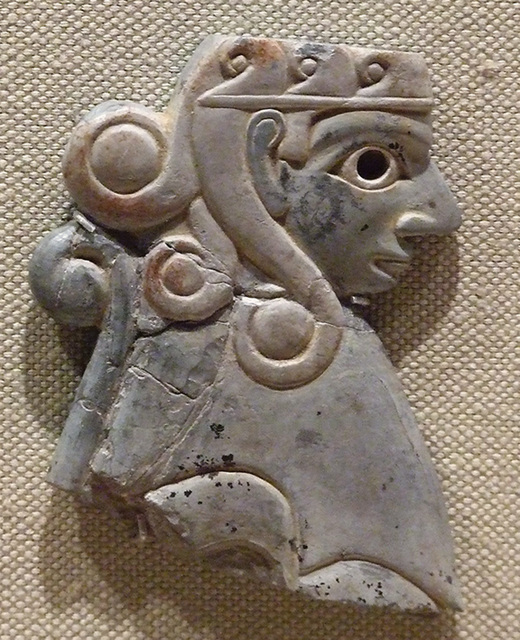Vessel Fragment in the Form of a Boar's Head in th…
Part of a Throne: Deity on a Bull in the Metropoli…
Beaker with Birds and Animals in the Metropolitan…
Cult Vessel in the Form of a Tower in the Metropol…
Silver Lid (?) with a Serpent in the Metropolitan…
Drawing of the Shell Engraved with Winged Female D…
Shell Engraved with Winged Female Deity, Sphinxes…
Plaque of Horse and Rider in the Metropolitan Muse…
Babylonian Man and Dog Statuette in the Metropolit…
Pin in the Form of a Lion in the Metropolitan Muse…
Pendant in the Shape of a Striding Lion in the Met…
Plaque with a Nude Female Between Two Bearded Men…
Plaque with Two Male Figures Supporting a Roller i…
Fish-Shaped Vessel in the Metropolitan Museum of A…
Molded Plaque with Couple in the Metropolitan Muse…
Molded Plaque with Couple in the Metropolitan Muse…
Cuneiform Tablet with Gilgamesh's Name in the Metr…
Plaque with the Face of Humbaba in the Metropolita…
Mastiff in the Metropolitan Museum of Art, August…
Mastiff in the Metropolitan Museum of Art, August…
Mastiff in the Metropolitan Museum of Art, August…
Molded Plaque with a Mastiff in the Metropolitan M…
Hittite Vessel in the Metropolitan Museum of Art,…
Head of a Female in the Metropolitan Museum of Art…
Human-headed Winged Lion (Lamassu) in the Metropol…
Human-headed Winged Bull (Lamassu) in the Metropol…
Detail of a Human-headed Winged Bull (Lamassu) in…
Assyrian Reliefs in the Metropolitan Museum of Art…
Assyrian Relief in the Metropolitan Museum of Art,…
Battle Scene of Assyrians Storming a Citadel in th…
Assyrian Relief of Cavalrymen Crossing a Mountain…
Foreign Groom in a Tributary Procession Relief in…
Foreign Groom in a Tributary Procession in the Met…
Head of a Beardless Royal Attendant in the Metropo…
Assyrian Male Apkallu Figure with a Fish-Skin Hood…
Molded Plaque with an Eagle-Headed Apkallu in the…
Molded Plaque with an Eagle-headed Apkallu in the…
Pendant with the Head of Pazuzu in the Metropolita…
Amulet with a Lamashtu Demon in the Metropolitan M…
Amulet with a Lamashtu Demon in the Metropolitan M…
Ivory Chair Back with a Tree Pattern in the Metrop…
Ivory Horse Blinker with a Seated Sphinx Wearing a…
Horse Blinker with an Egyptian Wedjat Eye in the M…
Ivory Head of a Roaring Lion in the Metropolitan M…
Ivory Head of a Man in the Metropolitan Museum of…
Location
See also...
Keywords
Authorizations, license
-
Visible by: Everyone -
All rights reserved
-
758 visits
Ivory Furniture Plaque: Female Sphinx with Hathor Style Curls in the Metropolitan Museum of Art, August 2008


Furniture Plaque: Female Sphinx with Hathor Style Curls
Ivory (hippopotamus)
Central Anatolia, probably Acemhoyuk
Old Assyrian Colony period, 1870-1740 BC
Accession # 36.70.11
Text from the Metropolitan Museum of Art label.
and
Anatolia in the Old Assyrian Colony Period
In the early second millennium BC, Assyrians established a trade route from Ashur in northern Mesopotamia to central Anatolia. At cities like Kultepe (ancient Kanesh), Acemhoyuk, and Bogazkoy (ancient Hattusha), they created market centers, or karums, where they exchanged valuable tin and textiles for silver. Despite periods of destruction, this long-distance network survived for almost two hundred years.
A group of hippopotamus-ivory carvings attributed to Acemhoyuk and give to the Metropolitan Museum of Art in the 1930s demonstrates the combination of local and foreign traditions found in material excavated at the trading centers of central Anatolia. The ivories exhibit Egyptian and Near Eastern characteristics that persisted over several centuries in the art of the following Hittite period.
Text from the Metropolitan Museum of Art plaque.
Ivory (hippopotamus)
Central Anatolia, probably Acemhoyuk
Old Assyrian Colony period, 1870-1740 BC
Accession # 36.70.11
Text from the Metropolitan Museum of Art label.
and
Anatolia in the Old Assyrian Colony Period
In the early second millennium BC, Assyrians established a trade route from Ashur in northern Mesopotamia to central Anatolia. At cities like Kultepe (ancient Kanesh), Acemhoyuk, and Bogazkoy (ancient Hattusha), they created market centers, or karums, where they exchanged valuable tin and textiles for silver. Despite periods of destruction, this long-distance network survived for almost two hundred years.
A group of hippopotamus-ivory carvings attributed to Acemhoyuk and give to the Metropolitan Museum of Art in the 1930s demonstrates the combination of local and foreign traditions found in material excavated at the trading centers of central Anatolia. The ivories exhibit Egyptian and Near Eastern characteristics that persisted over several centuries in the art of the following Hittite period.
Text from the Metropolitan Museum of Art plaque.
- Keyboard shortcuts:
Jump to top
RSS feed- Latest comments - Subscribe to the comment feeds of this photo
- ipernity © 2007-2024
- Help & Contact
|
Club news
|
About ipernity
|
History |
ipernity Club & Prices |
Guide of good conduct
Donate | Group guidelines | Privacy policy | Terms of use | Statutes | In memoria -
Facebook
Twitter

Sign-in to write a comment.